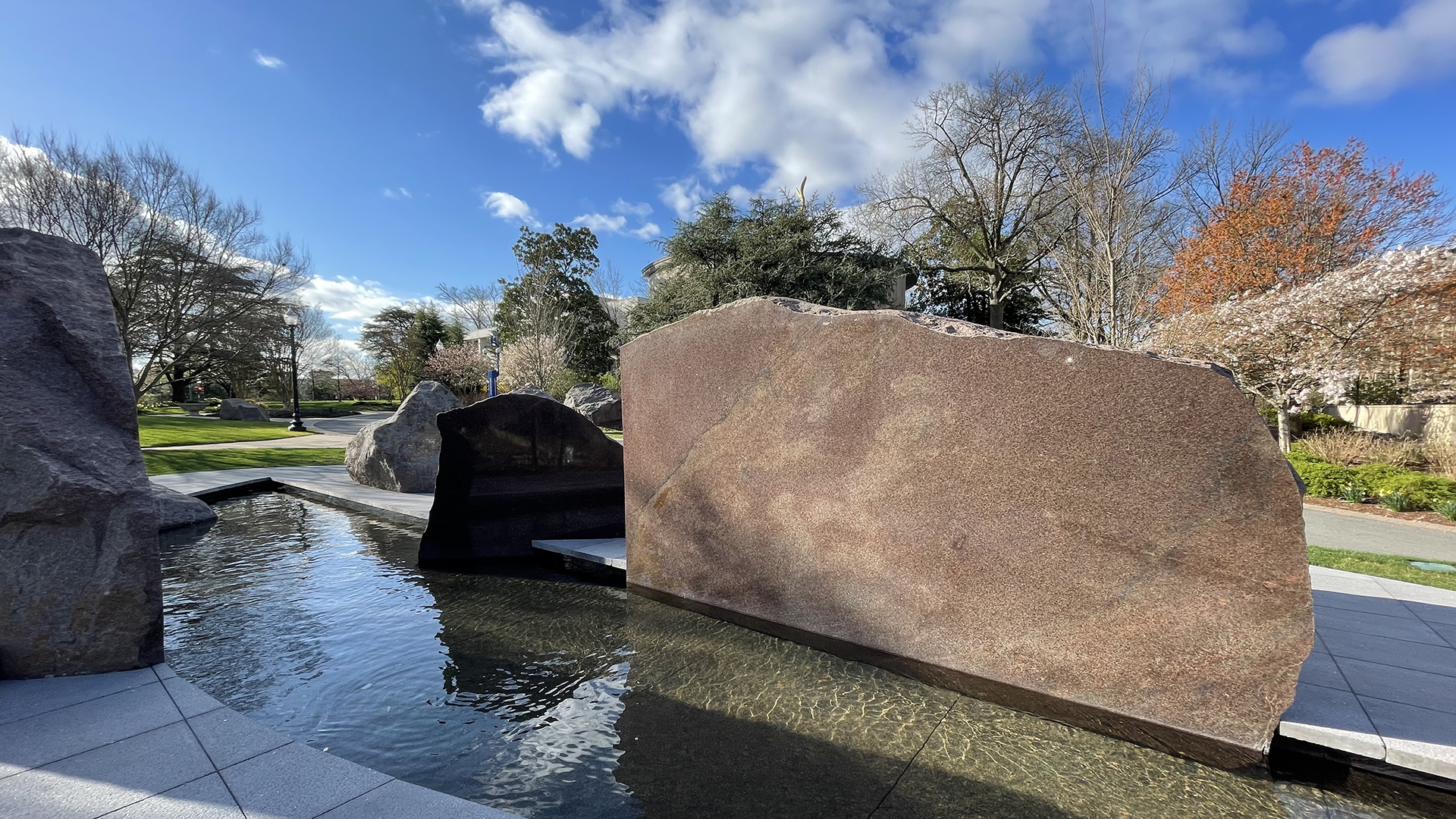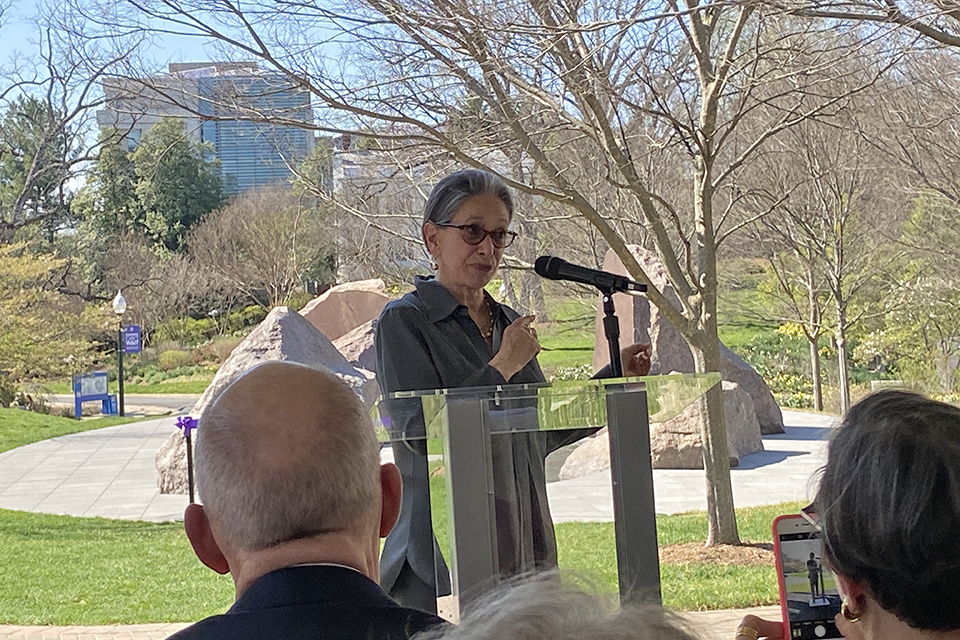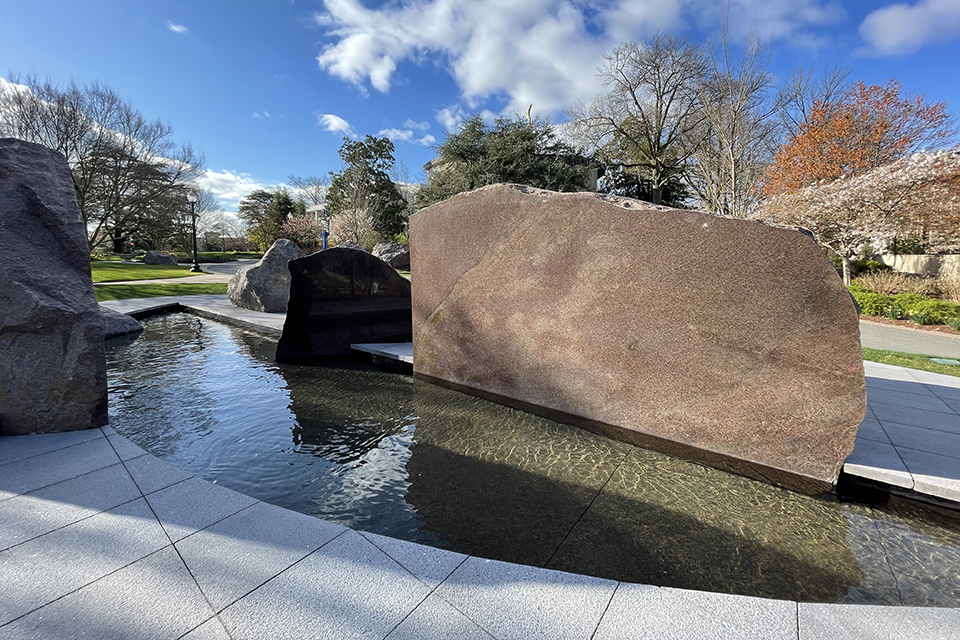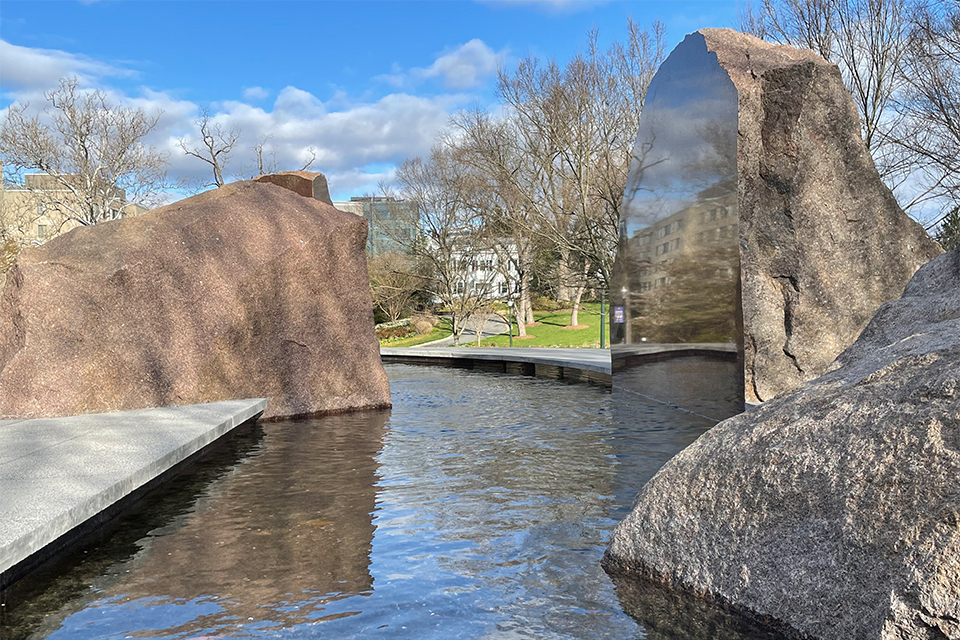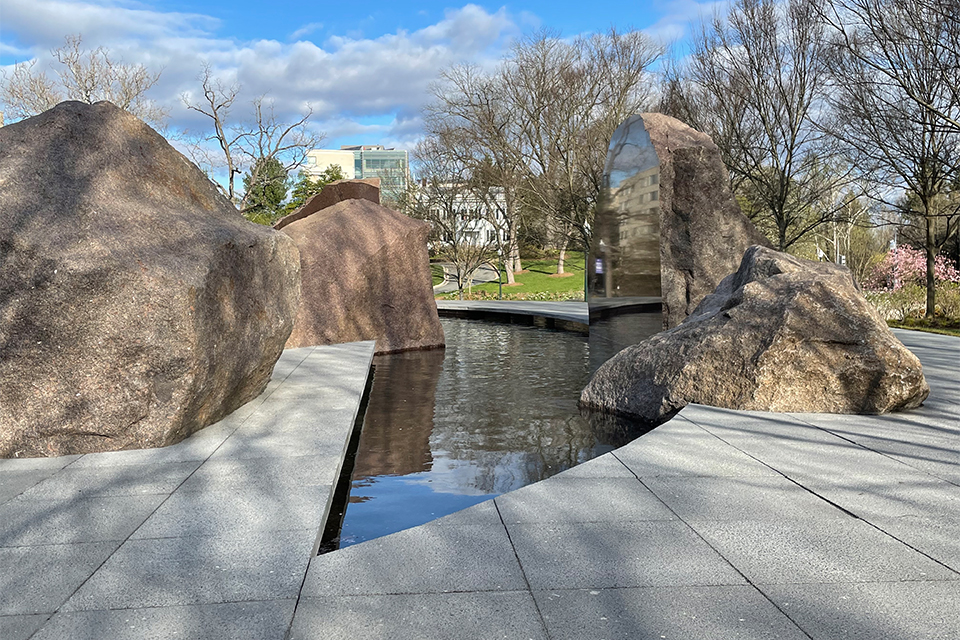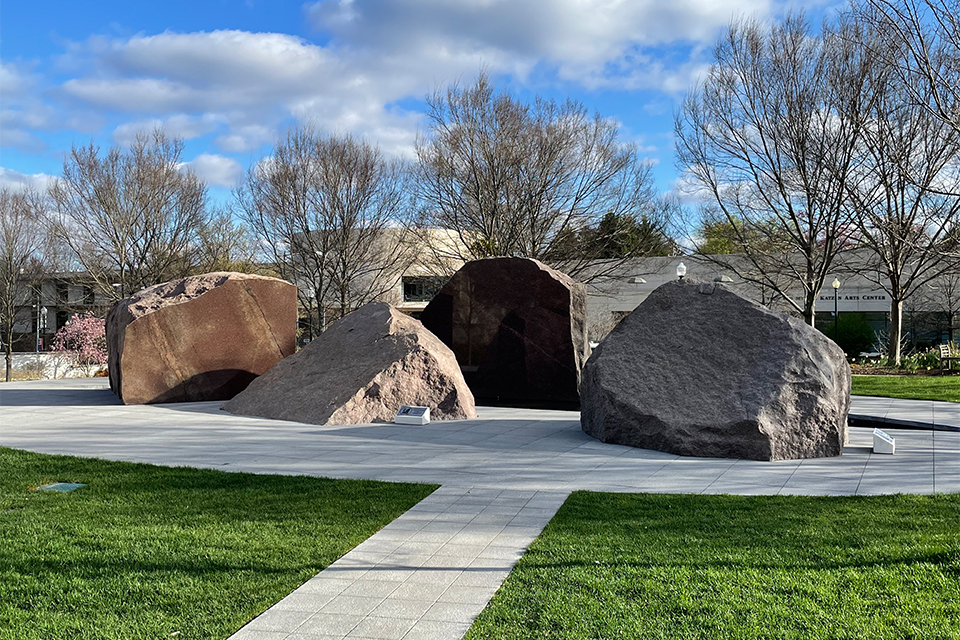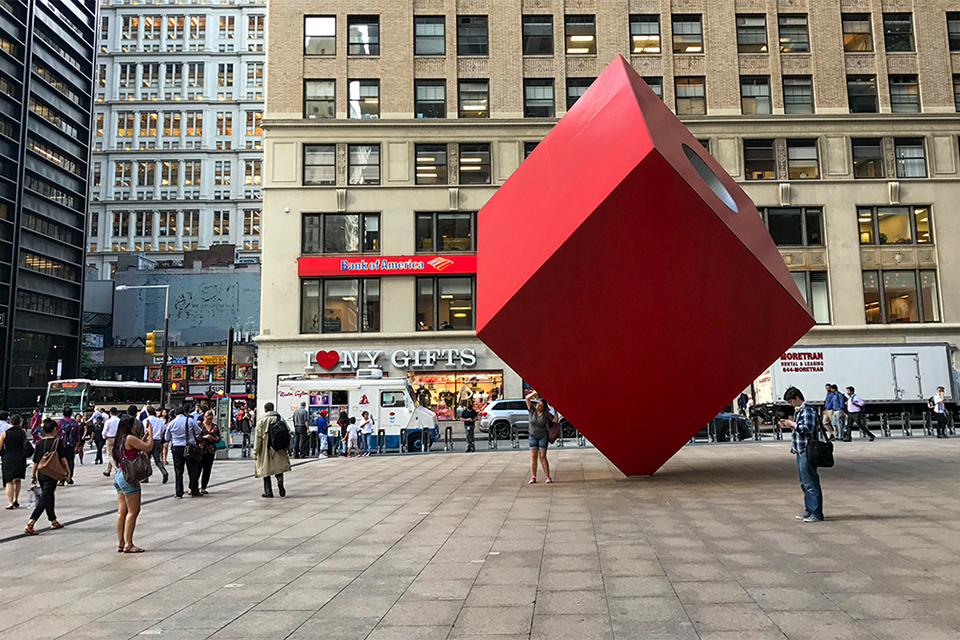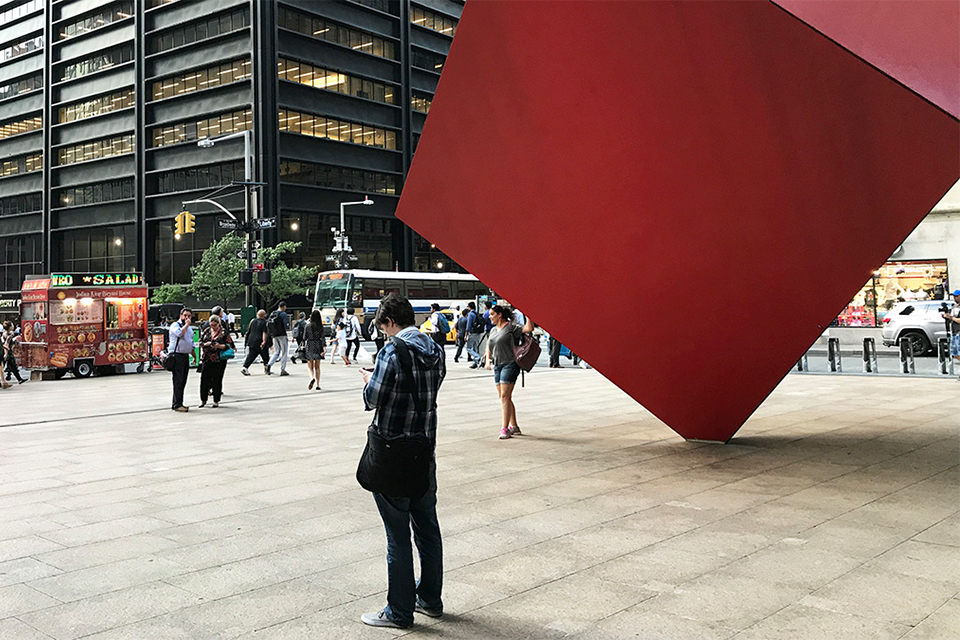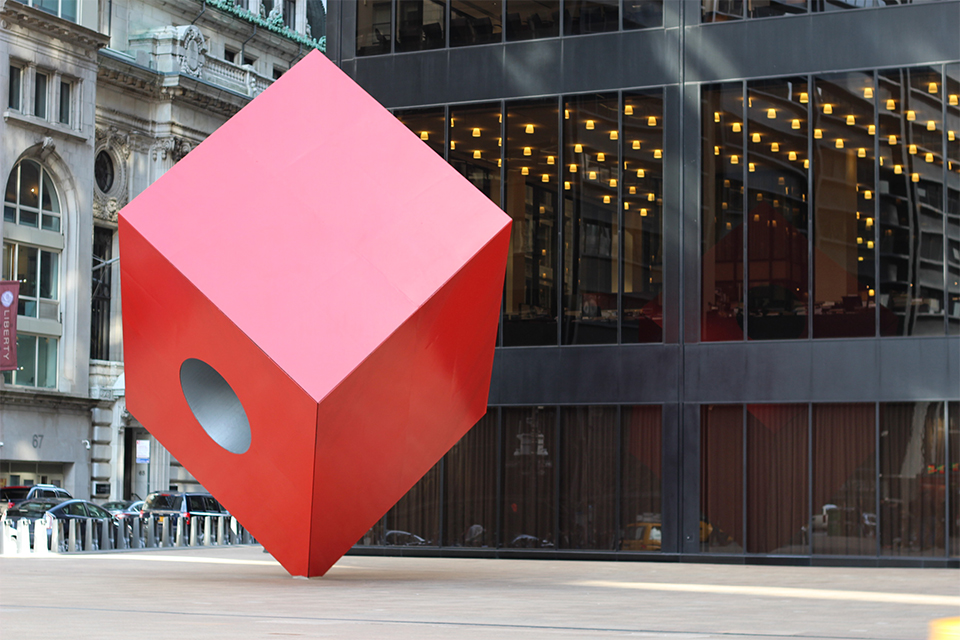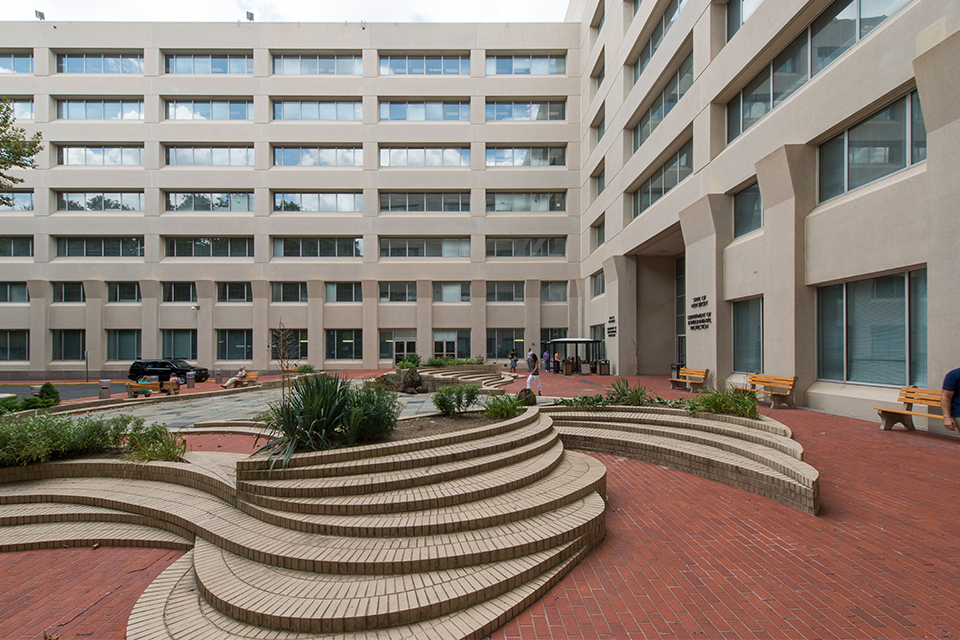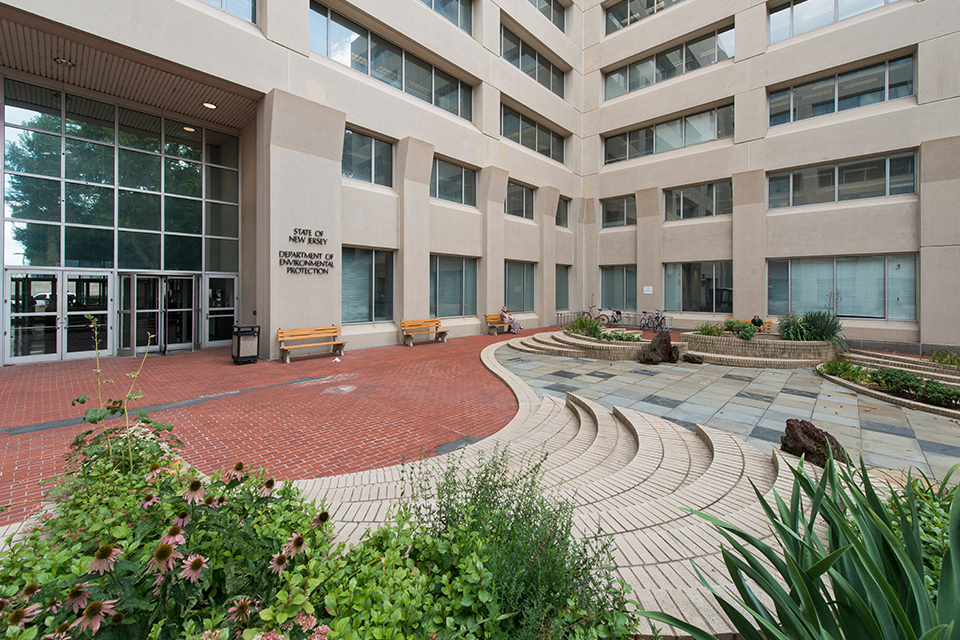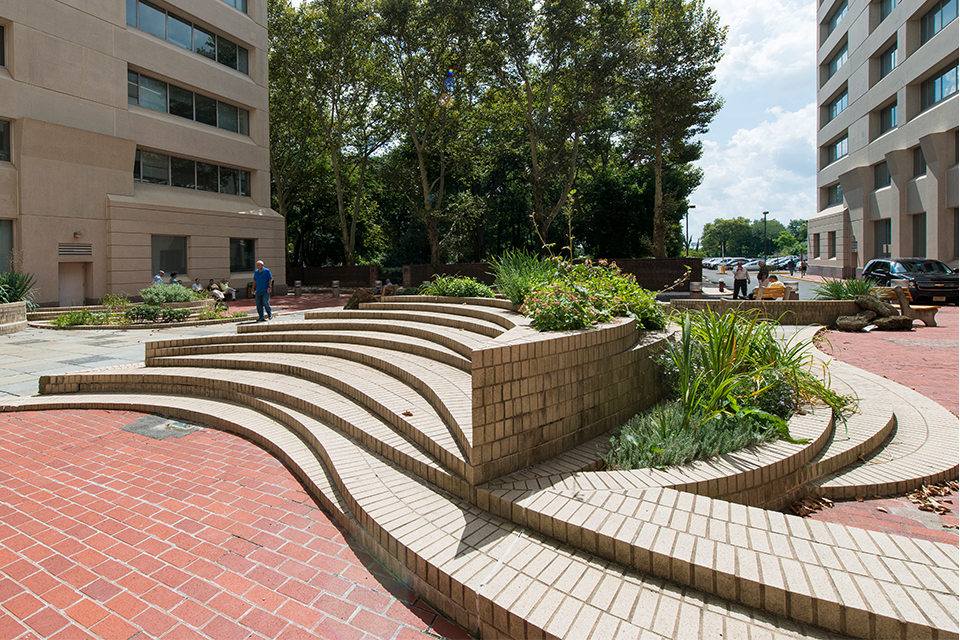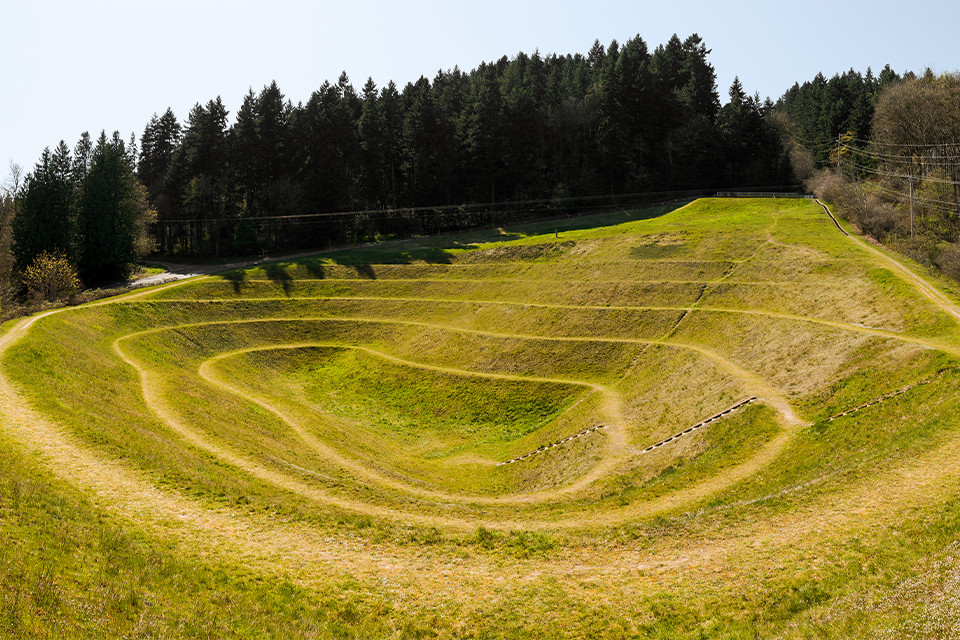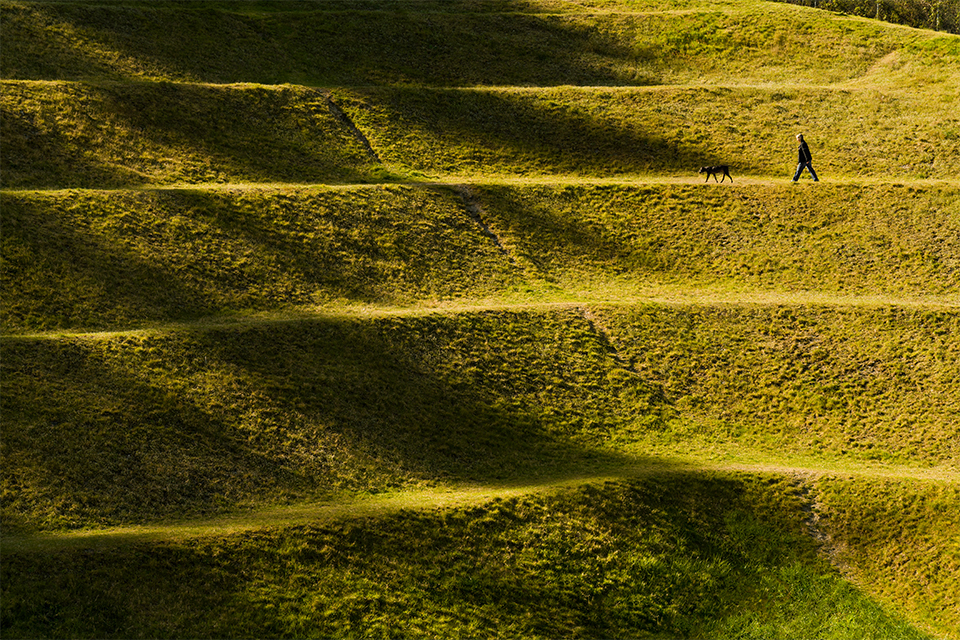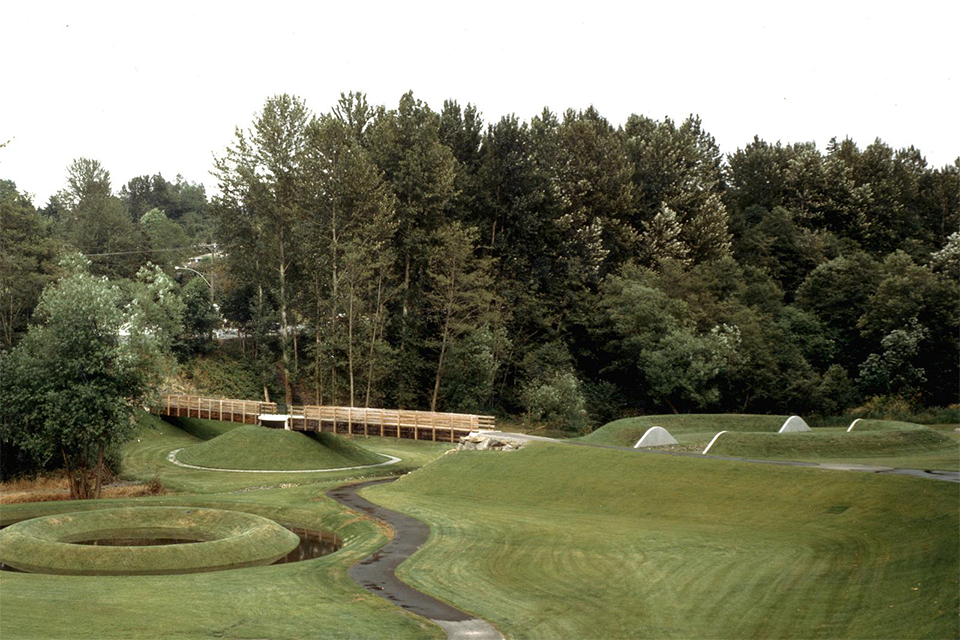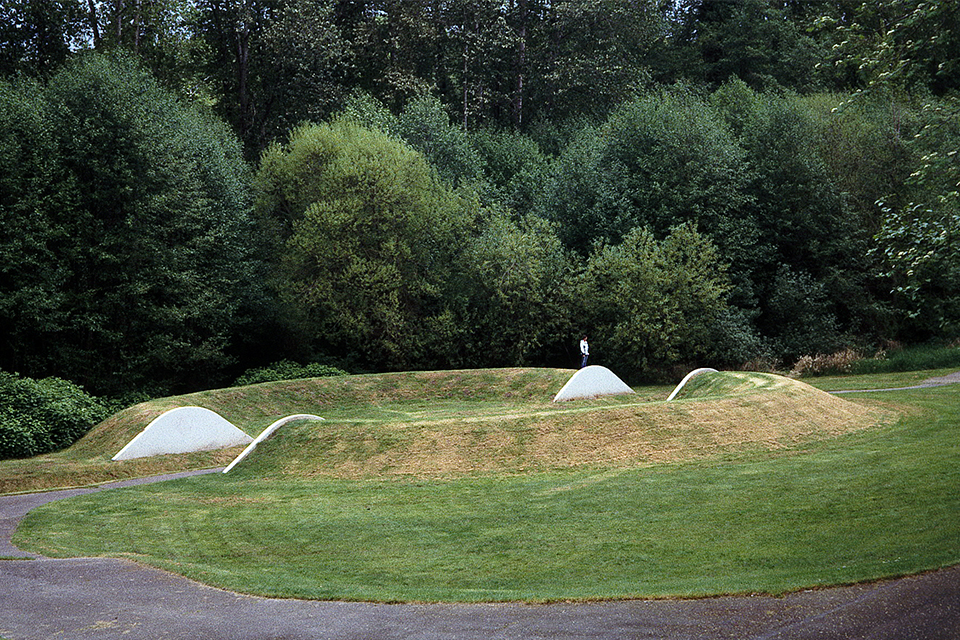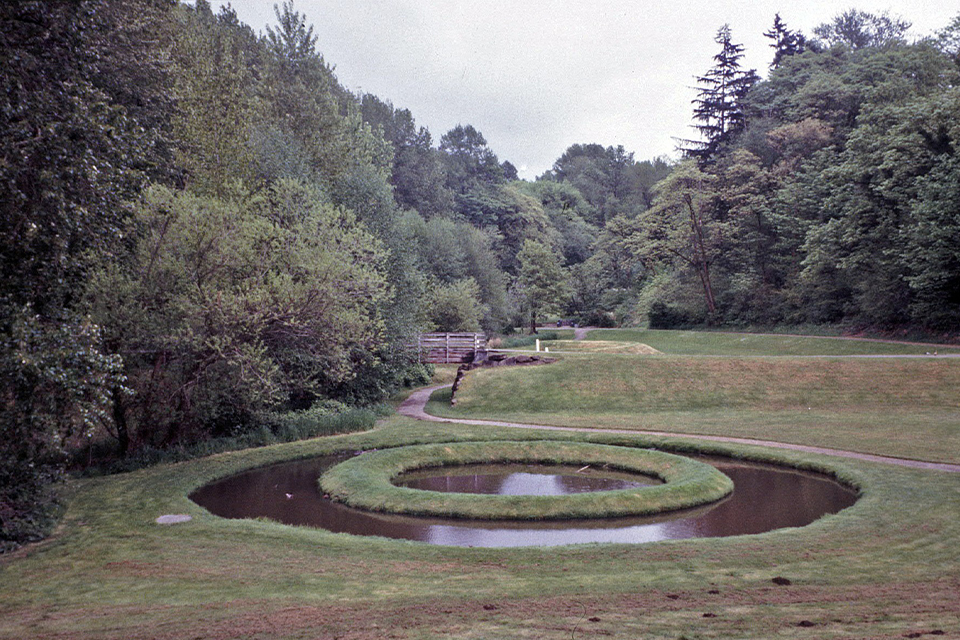“Art and the Landscape” comprises both art in the landscape and landscape as art; the lines between both are often blurred. In 2014 TCLF featured a range of sites as part of its Landslide report and digital exhibition, along with narratives and newly commissioned photographs for each. The sites included ancient petroglyphs, a designed garden, and sculpted earthworks and other site-specific installations. TCLF President and CEO Charles A. Birnbaum has noted: “Site-specific works of art in the landscape rank among the most organic and historically significant representations of our cultural identity and are often the most threatened.” Cultural landscapes in general are often at risk, viewed as tabula rasa, or as blank slates devoid of cultural significance, as is evidenced by multiple sites in this year’s report; when the element of art is added, the sites somehow become doubly vulnerable as debates swirl around value and usefulness.
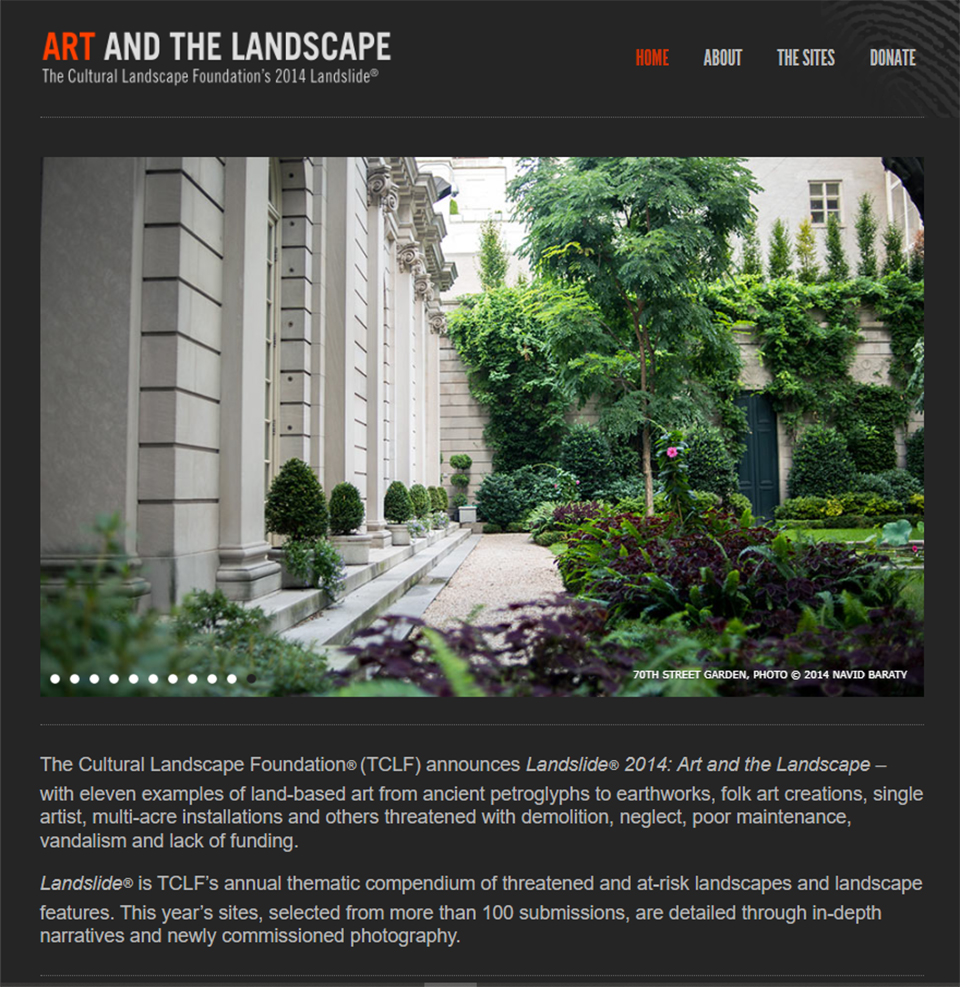 Screen Capture from Landslide 2014: Art and the Landscape Homepage. Image courtesy The Cultural Landscape Foundation.
Screen Capture from Landslide 2014: Art and the Landscape Homepage. Image courtesy The Cultural Landscape Foundation.
The presence of art in the landscape and the shaping of landscape into art attests to a powerful human ability to re-vision our surroundings and to invite others to do the same, whether viewing a tower through a hole in a 28-foot-tall red cube that appears miraculously balanced on one point, or transforming a derelict industrial landscape into an expansive and immersive work of public art. For the five sites below, TCLF’s advocacy and engagement involved bringing increased visibility to their historic significance and the dangers they were facing; for 140 Broadway and Green Acres TCLF mounted strategic communications and media campaigns that ultimately saved them from destruction while Sudama (MARABAR) was relocated and reimagined by the artist. In each case, continued stewardship involves an ongoing dialogue about what happens – ecologically, aesthetically, culturally, economically – when art and the landscape are merged.
Encompassing one square block in Lower Manhattan, this plaza and tower face Zuccotti Park, two blocks east of the World Trade Center. The site was designed by Gordon Bunshaft of Skidmore, Owings & Merrill between 1960 and 1964 as an open plaza surrounding a 51-story skyscraper with a shell comprising a matte-black-aluminum frame and glass. One of the first projects to conform to the 1961 Zoning Resolution that incentivized developers to incorporate public plazas into their office building plans, the tower has a trapezoidal footprint that covers approximately 40 percent of the property, with the remainder of the block designated as privately owned public space (POPS).
Background
The Modernist tower is a uniform slab with no setbacks and little ornamentation, surrounded on three sides by a 25- to 30-foot-wide sidewalk, which extends into an 80-foot-wide open plaza on the Broadway-facing side. The intended plaza design is a simple, stark plane composed of travertine pavers that extend to the curb, with few furnishings and devoid of street trees. The one major interruption to the otherwise pristine plaza is the Red Cube, a steel-and-aluminum painted vermillion cube by Japanese-American artist Isamu Noguchi. Installed in 1968 on the Liberty Street side of the plaza, the 28-foot-tall site-specific sculpture teeters on one edge. A circular hole punctures the center of the cube on its west face, inviting passersby to look up through it to the tower above.
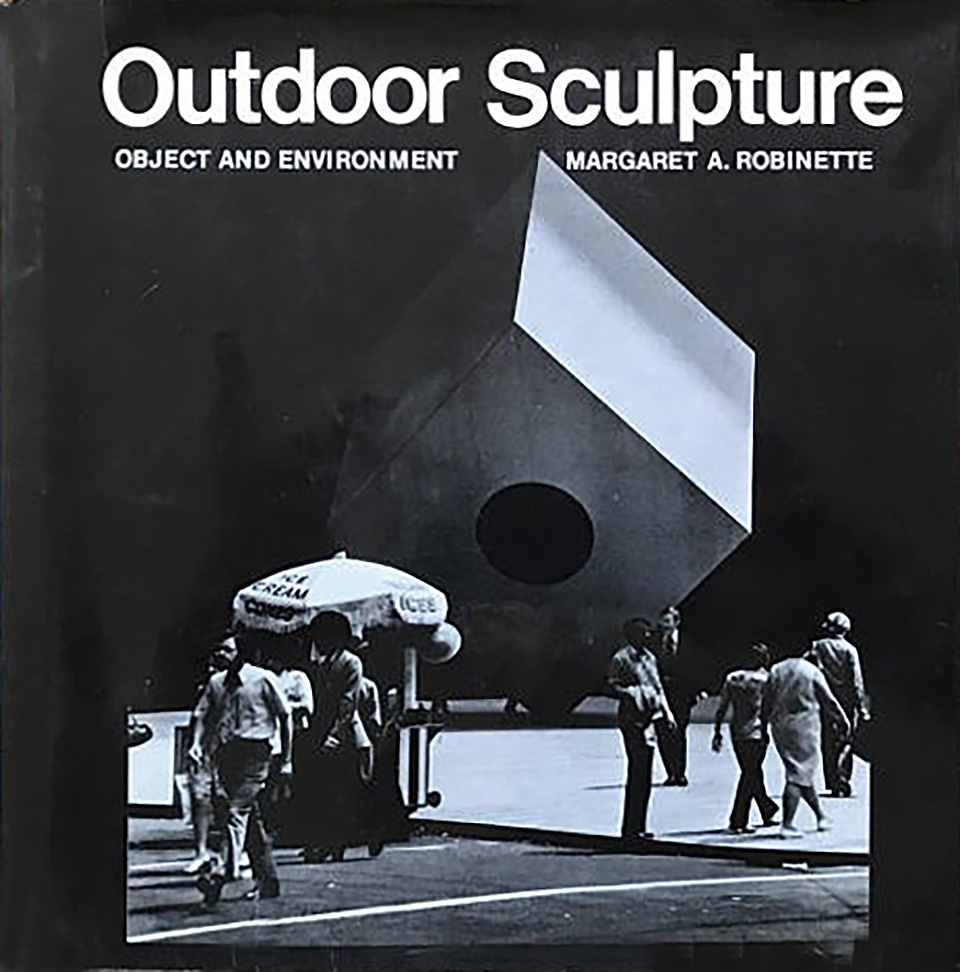 Cover of Outdoor Sculpture: Object and Environment by Margaret A. Robinette featuring Noguchi’s Red Cube, Whitney Library of Design, 1976.
Cover of Outdoor Sculpture: Object and Environment by Margaret A. Robinette featuring Noguchi’s Red Cube, Whitney Library of Design, 1976.
Noguchi made several large-scale sculptures for buildings by Skidmore, Owings & Merrill, often collaborating with Bunshaft. These include the interior courtyards and garden at the Connecticut General Life Insurance Company in Bloomfield, Connecticut (1956-1957); the plaza for the First National City Bank Building in Fort Worth, Texas (1960); the sculpture garden at the Beinecke Rare Book and Manuscript Library at Yale University in New Haven, Connecticut (1960-1964); and two rectangular courtyards for the IBM Corporation Headquarters in Armonk, New York (1961-1964). Less than two blocks to the east of the 140 Broadway site, Noguchi created a sunken garden at Chase Manhattan Bank (1961-1964), also working with Bunshaft.
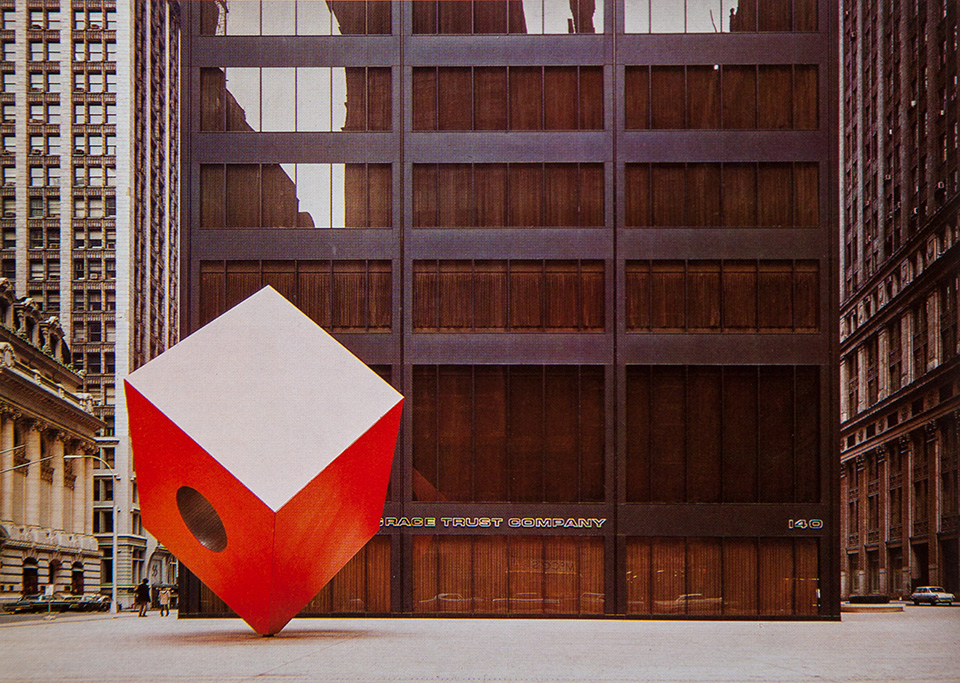 140 Broadway, New York, N.Y., Date Unknown
140 Broadway, New York, N.Y., Date Unknown
In 2000 alterations were made to Cedar Street, including the addition of black granite benches, four raised linear granite planters, concrete sidewalk paving, and a black granite slab with gold lettering in memory of real estate mogul Harry Helmsley. Citi Bike racks were installed along Liberty Street in 2013, the same year that the building was designated a New York City Landmark.
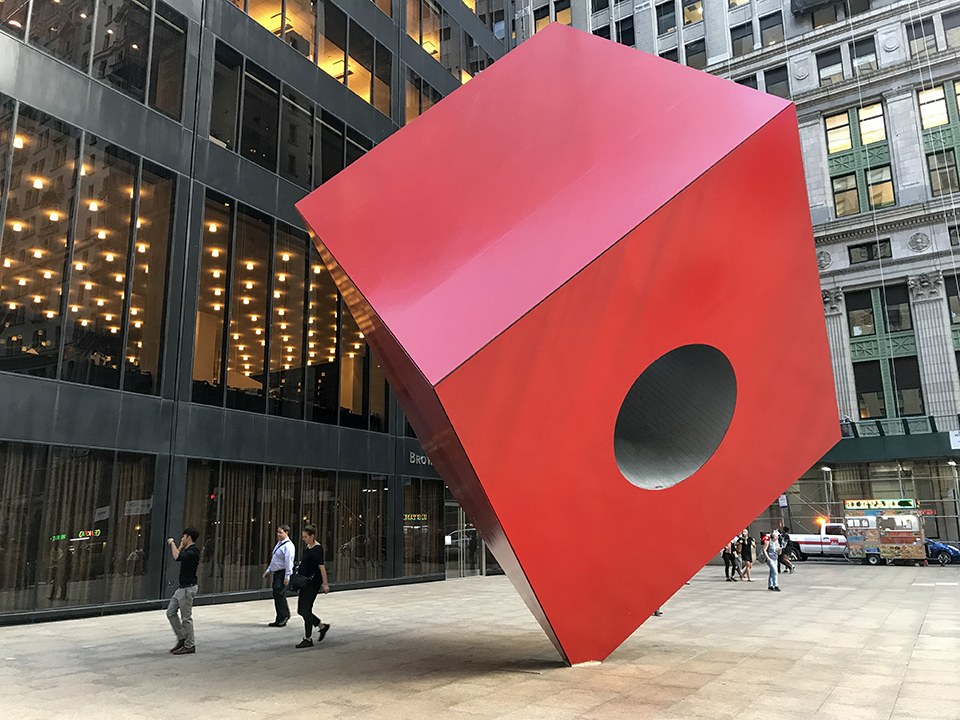
140 Broadway, New York, N.Y, 2018. Photo by Charles A. Birnbaum, courtesy The Cultural Landscape Foundation.
Advocacy and Engagement for 140 Broadway
The property is owned by the Hamburg, Germany-based Union Investment Real Estate company, GmbH. On January 22, 2018, the Tribeca Trib reported that the building owners were asking the New York City Landmarks Preservation Commission (LPC) to approve a plan, prepared by the landscape architecture firm NV5 and preservation consultants Higgins Quasebarth & Partners, to renovate and redesign the Modernist plaza. The initial proposal called for removing several elements introduced to the plaza after the original 1960s design, but also for adding several new features, including a raised, circular planting bed, fourteen feet in diameter, at the southwestern corner of the block. The large new feature, planted with trees, would have fundamentally altered the site’s key visual and spatial organization by negating artist Isamu Noguchi's iconic Red Cube as the singular, dominant element in the plaza. The plan alarmed several advocacy groups, including TCLF, which enrolled 140 Broadway in its Landslide program as an at-risk landscape on January 29 and wrote a letter to the LPC voicing strong objections. Originally scheduled to be presented on February 6, 2018, the proposal was pulled from the LPC docket after a firestorm of public criticism over the proposed renovation.
A revised proposal by NV5 and Higgins Quasebarth & Partners went before the LPC on March 20, 2018. In this plan, the large circular planter, which would have changed the compositional balance of the plaza, was notably absent. The black granite plaque that currently protrudes from the ground plane, paying tribute to real estate mogul Harry Helmsley, would be replaced with another plaque to Helmsley inserted flush with the pavement. Six circular planters, each fourteen feet in diameter, with engaged seating, would line the perimeter of the block along Cedar Street, replacing the four raised, linear planting boxes that were added there after the 1960s design. A dozen stainless steel light stanchions were also proposed along Cedar Street, and the plaza’s granite pavers, installed in 1999, were to be replaced with new ones that resembled the original travertine pavement. The LPC provisionally approved most elements of the new plan; however, the new stainless steel light stanchions were eliminated.
Noguchi believed the sculptor’s task was to shape space, to give it order and meaning. The spatial organization of 140 Broadway received much public and media attention because of the presence of Noguchi’s iconic Red Cube. Furthermore, the advocacy campaign promoted the idea that open space can be, by design, intentional and/or character designing. This recognized significance by the New York City Landmarks Preservation Commission continues to serve as an important reminder that this value exists; we need only look for it.
In 1985 the New Jersey State Council for the Arts held a design competition for a work of public art to be placed in the interior courtyard of the State’s Department of Environmental Protection. Located in the heart of Trenton, one mile east of the Delaware River, the U-shaped, Brutalist-style, seven-story building encloses a courtyard that faces into the adjacent, arboreal Mercer Cemetery. Environmental artist Athena Tacha was awarded the commission. Her site-specific environmental sculpture, called Green Acres after the department’s land protection program, was completed in 1986 and dedicated in 1987 by Governor Thomas Kean.
Background
Tacha’s biomorphic earthwork is built into the ground plane of the red tiled courtyard and is surrounded on three sides by the buff-colored, concrete walls of the office building. The sculpture invites active participation from its viewers and is meant to be experienced both from the ground and from above. Measuring 77 feet by 85 feet and rising five feet at its highest points, the gracefully curving and scalloped forms produced by stacked, white-colored bricks are evocative of ocean waves or tidal eddies. The brick ledges are pierced by crescent-shaped planters that provide a verdant counterpoint, filled with ground covers and blossoming yuccas, and the flowing brick steps provide natural seating along the edges. In the center is a small plaza paved with 46 granite square tiles of varying green and blue hues, onto which a handful of photographs depicting the state’s endangered landscapes, flora, and fauna have been sandblasted. Tacha’s use of sandblasted images in her work was considered a new technique at its time.
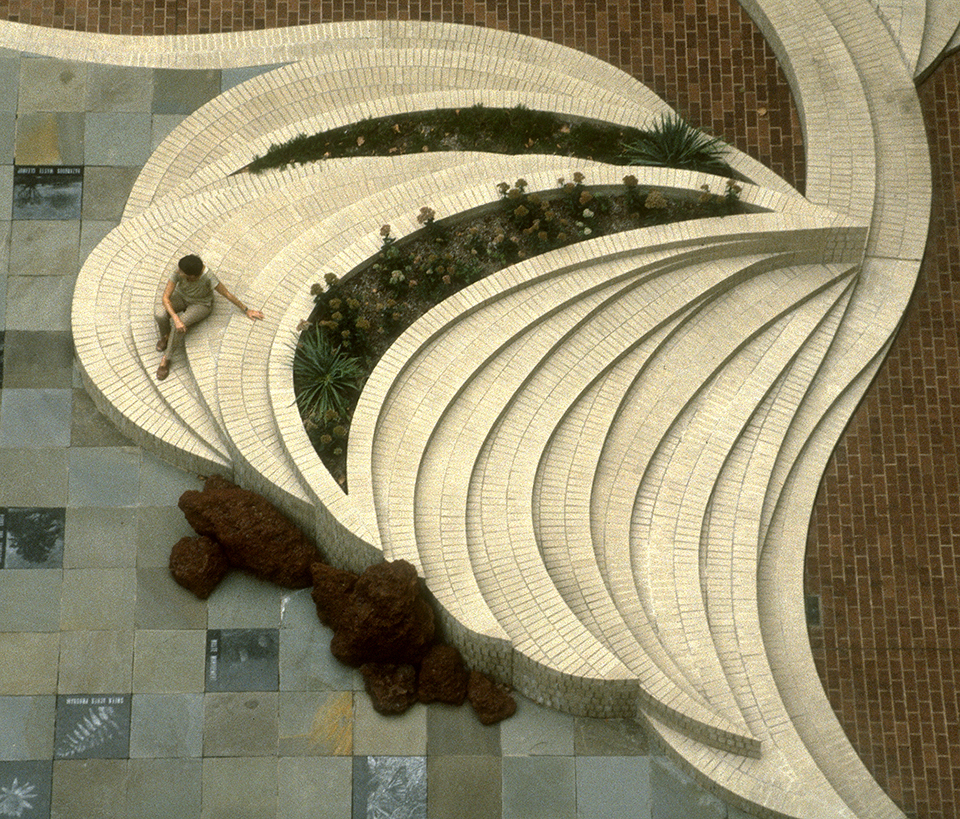 Green Acres, Trenton, NJ, 1988. Photo by Richard E. Spears, courtesy Athena Tacha.
Green Acres, Trenton, NJ, 1988. Photo by Richard E. Spears, courtesy Athena Tacha.
An April 18, 2012 New Jersey Treasury Department letter informed Tacha that Green Acres would be destroyed on or after July 31, 2012 (received May 9, 2012) – the only alternative offered was removal of the sculpture at the artist’s expense. Green Acres had suffered from years of deferred maintenance and the Treasury Department asserted maintenance funding was not available. The letter also stated that the piece posed a public safety risk during an emergency by impeding the evacuation of the building, an issue never before raised in the plaza’s 25-year history. At the time, Green Acres was one of more than 40 U.S. commissions produced during a 35-year-period by Tacha at locations ranging from New York to Alaska, including an entire city-block park in downtown Philadelphia.
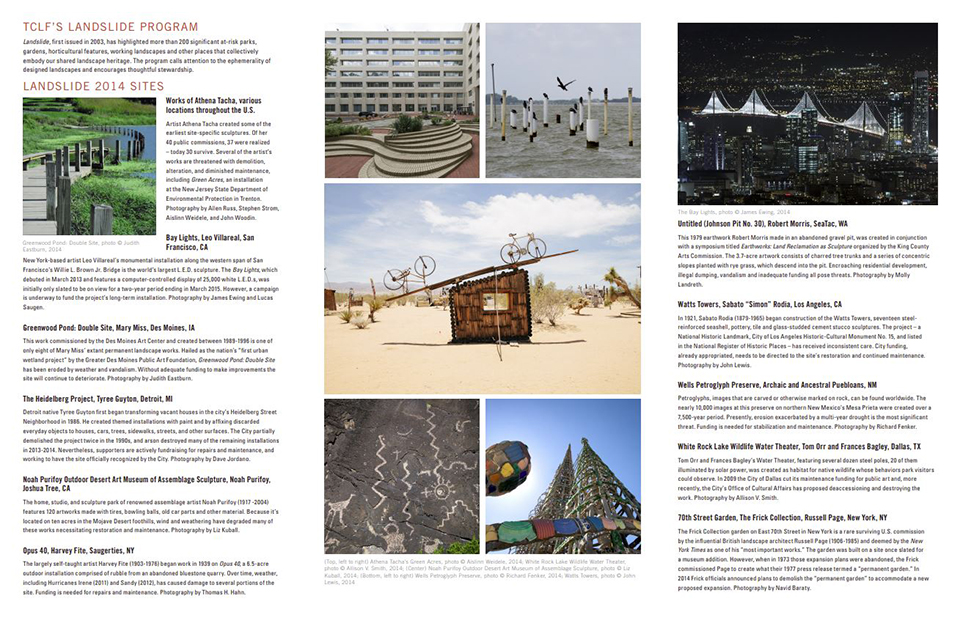
Landslide 2014: Art in the Landscape Brochure, 2014. Image courtesy The Cultural Landscape Foundation.
Advocacy and Engagement for Green Acres
Following the site’s July 2012 enrollment in its Landslide program of at-risk landscapes, TCLF initiated a multi-pronged campaign to prevent Green Acres’ demolition, enlisting support from several organizations, among them Preservation New Jersey and ArtPride NJ. Pressure mounted throughout the summer as the campaign generated extensive coverage from the Associated Press, Newark Star Ledger, Philadelphia Inquirer, Times of Trenton, along with Architect Magazine, the the Art Market Monitor, Artinfo.com, ASLA The Dirt, the Huffington Post, Landscape Architecture Magazine, and many others. Finally, in a stunning reversal, on August 23, , Governor Chris Christie, through his policy advisor Amy Cradic, informed Tacha of the decision not to demolish Green Acres. Instead, the installation would be rehabilitated.
While the installation was saved, efforts to rehabilitate it were slow to take place. In 2013, Green Acres was documented by the Historic American Landscape Survey (HALS), which can be found at the Library of Congress (NJ-5). The HALS statement of significance noted: “[W]ith the crucial help of the Cultural Landscape Foundation, [and] after nationwide publicity decrying the plan and a petition to save the work with more than 400 international signatures, Governor Christie issued an order that it must be preserved.”
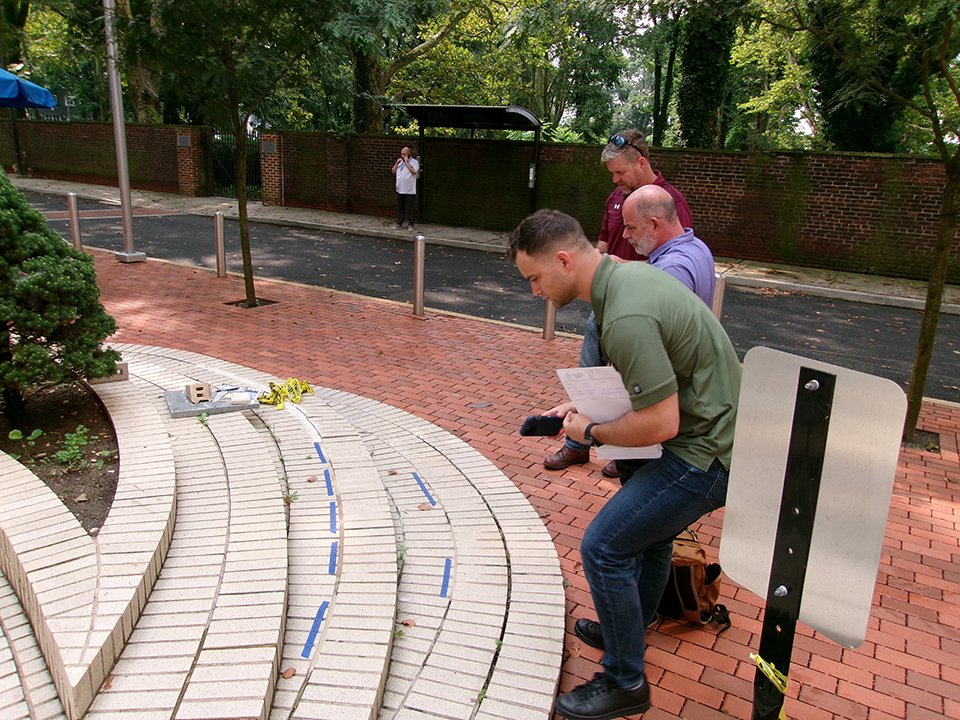 Masonry restoration, Green Acres, Trenton, NJ, Date Unknown. Photo courtesy Sean Ryan.
Masonry restoration, Green Acres, Trenton, NJ, Date Unknown. Photo courtesy Sean Ryan.
The threat to Green Acres drew increased recognition and exposed threats to other works by the artist and in 2014 TCLF enrolled the works of Athena Tacha in the Landslide report and digital exhibition Art and the Landscape, which received extensive coverage in the Washington Post, Los Angeles Times, ABC News, Huffington Post, Charlotte Observer, Michigan Radio, ArtNet News, Curbed, Architizer, Arch Daily, a multi-page spread in the Art Newspaper, and many other outlets.
Fortunately, as of August 2023, the New Jersey Department of Environmental Protection is in the process of contracting for a restoration project that would include the following: full brick repointing; localized brick rebuild and replacement; localized resetting of slate pavers; power wash and clean with a light detergent; and the possible replacement of the 49 etched granite pavers.
Starting in the 1960s, post-industrial and derelict landscapes seen as visual and environmental blights became, in the hands of some artists, provocative installations that reclaimed the land. Untitled Earthwork (Johnson Pit # 30), an early monumental installation designed by the American artist, Robert Morris, is among the first land reclamation art projects in the country.
Background
In 1978 the King County Arts Commission in Seattle, Washington engaged artists to propose solutions for degraded surplus land on former industrial sites (what the commission’s executive director called “technologically abused land”) in the greater Seattle area. The commission held a symposium titled Earthworks: Land Reclamation as Sculpture in August 1979 that included a demonstration project. The commission worked with the Department of Public Works (DPW), which oversaw more than 100 gravel pits, and selected the Johnson Pit (number 30 on the county’s list), declared surplus land in 1973, as a suitable site for the demonstration project.
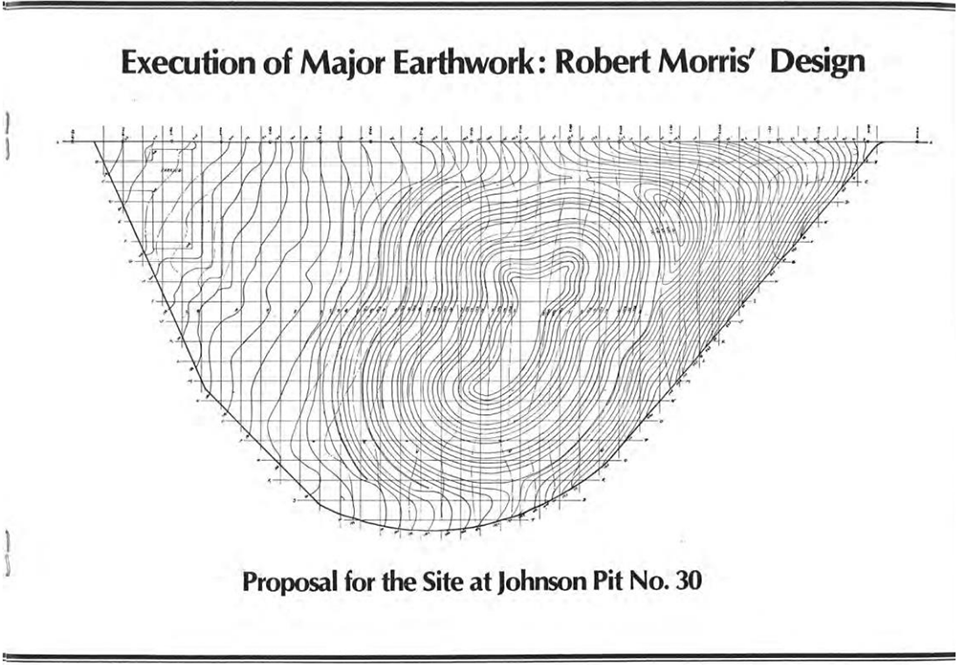 Proposal for Untitled Earthwork (Johnson Pit # 30) from symposium catalog, SeaTac, WA, 1979. Image from Series 278, King County Archives, Seattle, WA, courtesy NPS.
Proposal for Untitled Earthwork (Johnson Pit # 30) from symposium catalog, SeaTac, WA, 1979. Image from Series 278, King County Archives, Seattle, WA, courtesy NPS.
Of the 22 artists who were invited to submit proposals, eleven did so and a three-person jury selected Morris to work on Johnson Pit # 30, which DPW donated to the county. The work was funded by a unique consortium of the U.S. Department of the Interior, National Endowment for the Arts, King County Department of Public Works, and the U.S. Bureau of Mines – the last of which had never before funded the creation of artwork.
Construction of Morris’ artwork began concurrent with the August 1979 symposium and was completed before the year’s end. Proposals by six other artists – Iain Baxter, Richard Fleischner, Lawrence Hanson, Mary Miss, Dennis Oppenheim and Beverly Pepper – for different sites were also featured at the symposium, along with a design by Herbert Bayer, Mill Creek Canyon Earthworks (see below) for a site in Kent, Washington. Completed in November 1979, Morris’ 3.7-acre earthwork is set into a hillside overlooking the formerly rural Kent Valley and the Cascade Mountains beyond. The work consists of a series of concentric terraced slopes planted with rye grass that descend into the pit, located in the center of the site. Morris cleared the center of vegetation and along the slope of the pit’s northwest edge, he left a line of blackened tree stumps as a symbolic “ghost forest,” a reminder of the once forested land that had been lost.
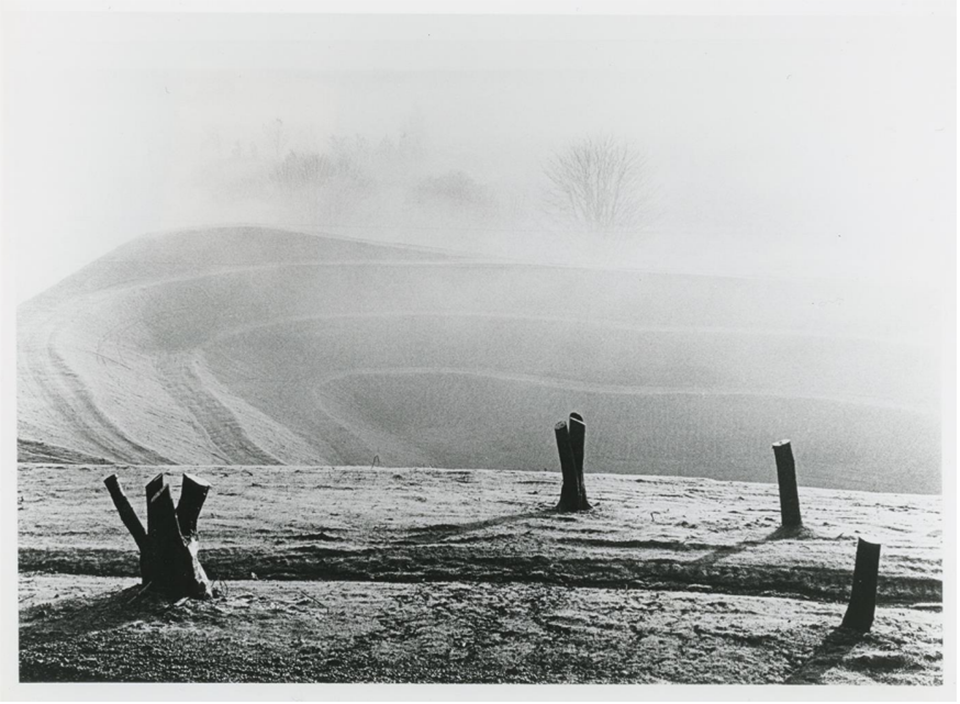 Untitled Earthwork (Johnson Pit # 30), SeaTac, WA, 1979. Photo by Colleen Chartier from Series 1747, King County Archives, Seattle, WA, courtesy NPS.
Untitled Earthwork (Johnson Pit # 30), SeaTac, WA, 1979. Photo by Colleen Chartier from Series 1747, King County Archives, Seattle, WA, courtesy NPS.
The 1979 symposium and the two realized projects set a precedent, which helped to redefine the country’s notion of public art early in the development of government-funded public art programs. Until then city and county public art programs typically commissioned large-scale works for public locations such as a plaza, city park, or government building, and not land reclamation art. The King County Arts Commission helped pioneer a new type of land-use policy by asserting that contemporary artists can and should be instrumental in envisioning solutions for civic issues, and involving them on project teams to design water, utility, infrastructure, and transit systems. The concept that artists’ ideas could shape our built environment as well as our civic life and public policy decisions was a major and permanent innovation in public art programs nationally.
In 1994 the King County Arts Commission, following the recommendations of a study group it had convened a year earlier, began rehabilitating the site. In consultation with Morris, a wooden pathway, constructed of reclaimed fir beams, was built leading to the basin in order to direct visitors and discourage erosion on the terraces. Wooden benches were also added and the blackened tree stumps from Morris’s “ghost forest” were replaced. Despite rehabilitation efforts, upkeep and maintenance were a challenge and the fir beams deteriorated rapidly. By 2014 the beams were approaching the end of their life span, and the site suffered from vandalism and illegal dumping.
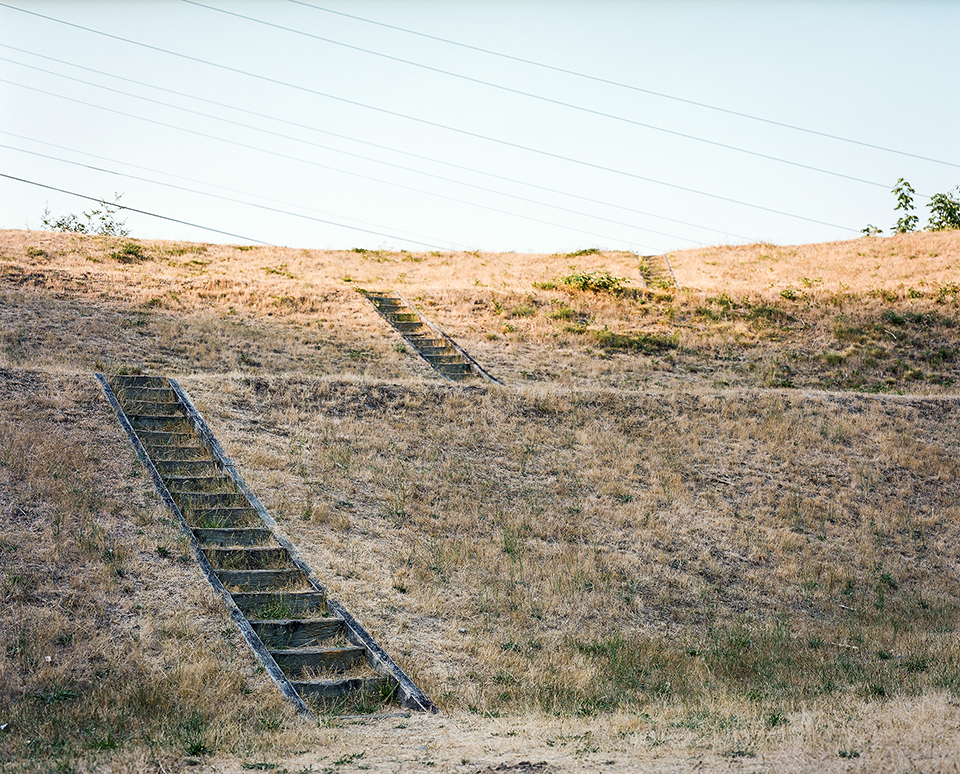
Untitled Earthwork (Johnson Pit # 30), SeaTac, WA, 2014. Photo by Molly Landreth, courtesy The Cultural Landscape Foundation.
Advocacy and Engagement for Green Acres
4Culture, a cultural services agency that replaced the King County Arts Commission and the County Office of Cultural Resources in 2003, took precautions to protect the site. While the agency prevented nighttime access, the site remained under threat, leading TCLF to enroll the property in the 2014 Landslide thematic report, Art and the Landscape. The report and digital exhibition (which included the Frick Collection’s Russell Page-designed viewing garden and Harvey Fite’s Opus 40, also in this year’s report) featured narratives and newly commissioned photography, highlighting eleven examples of land-based art – from ancient petroglyphs to earthworks, folk art creations, single artist, multi-acre installations and others – threatened with demolition, neglect, poor maintenance, vandalism, and lack of funding. TCLF urged the public to assist with donations to supplement the maintenance budget of Morris’s earthwork and to support applications for the site’s designation as a King County Landmark and listing in the National Register of Historic Places. 4Culture featured TCLF’s exhibition on its website in October 2014.
The following year the Washington Trust for Historic Preservation designated the site as one of the state’s “Most Endangered Places”; in 2018 4Culture rebuilt the retaining wall at the edge of the small parking lot west of the installation, restored a bench and bridge, and upgraded the trail and stairs with new gravel and timber. Regardless, maintenance issues and illegal dumping continued to plague the site even as a National Registration nomination was being prepared. TCLF’s Landslide update in February 2021 said designation would “bring additional attention to the site’s preservation needs and solidify a sense of pride in the pioneering project,” and urged the public to submit letters of support to 4Culture’s Director of Public Art and/or to donate to the site’s maintenance fund. In August 2021 Untitled Earthwork (Johnson Pit #30) was finally listed in the National Register, the first for a contemporary artwork, blazing a path for other seminal, land-based artworks to follow.
Herbert Bayer’s Mill Creek Canyon Earthworks, a Modernist masterpiece created in 1982, is a series of sculpted spaces that feel both ancient and modern; the work’s pure forms—cones, circles, lines, and berms—are built into the alluvial delta at the canyon’s mouth.
Background
Located south of Seattle, the City of Kent, WA, was built on the banks of the White and Green Rivers, making flooding a constant threat during wet months. Diversion of the White River in the early 1900s and the later addition of a dam in the Green River reduced the severe flood hazard and allowed the town to expand from a predominantly agricultural community to a more industrial, commercial city and major transportation corridor.
In 1979 the King County Arts Commission convened a symposium entitled Earthworks: Land Reclamation as Sculpture, and invited eight artists to create reclamation plans, choosing from more than 100 industrial sites lying fallow in the county. The commission hoped to address the ecological issues at each site while converting the landscapes into usable community spaces through earthwork designs. At that time, the idea of earthworks as a legitimate art medium was seen as both ancient and unassailably modern. Aside from appreciation of prehistoric examples like Stonehenge, the contemporary popularity of land art began with the onset of the environmental movement in the mid-1960s. These earliest earth artists were seeking a new way to employ nature and to transform art. In actively engaging this movement, the King County symposium was groundbreaking and led to the establishment of significant public arts programs in the region as well as across the nation.
The impact of the Earthworks: Land Reclamation as Sculpture series was felt throughout the country, not just in King County. After closing at the Seattle Art Museum, the exhibition traveled across the United States and Canada for more than two years to a dozen major art museums. Previously, public art was confined to large-scale, studio work that did not consider the uniqueness of place or community in which it would eventually be inserted. The symposium helped shift the practice of public art toward a collaborative discipline that explored specificity. The symposium and the earthworks were instrumental in shifting the concept of public art from one of placing discrete works of art in public locations to creating artful public places with strong aesthetic qualities.
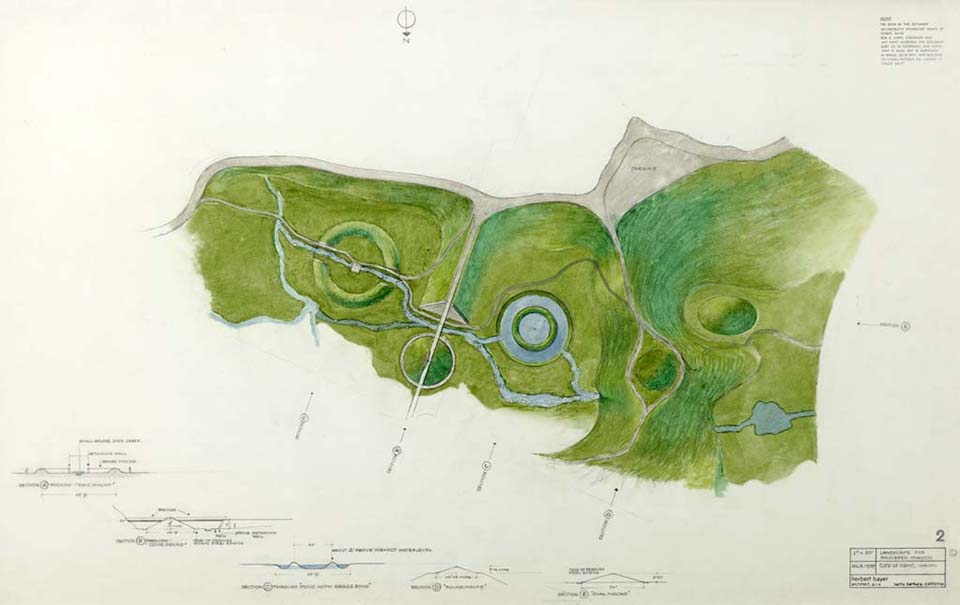 Mill Creek Canyon Earthworks, Kent, WA, 1979. Image by Herbert Bayer, Courtesy Kent Arts Commission.
Mill Creek Canyon Earthworks, Kent, WA, 1979. Image by Herbert Bayer, Courtesy Kent Arts Commission.
It was during this time that Herbert Bayer was engaged to produce a design for the Mill Creek Canyon site in Kent. The Bauhaus-educated artist had gained international renown during the 1950s with his designs for the redevelopment of Aspen, CO, from a dilapidated mining town to a world-class ski resort. Moreover, he had established himself as a pioneer of contemporary land art with his 1955 Earth Mound at the Aspen Institute. The education Bayer received at the Bauhaus shaped his life’s work as he gave himself over to the school’s philosophy of functional design. Bayer’s final environmental work in Kent’s Mill Creek Canyon Park combined the sculptural vocabulary of his Aspen projects with ecological functionalism.
The Earthworks is composed of a variety of topographic features, pathways, water features, and lawns which function together as a public park, stormwater retention facility, and landscape artwork. The 2.5-acre site, located in the northeast corner of the larger Mill Creek Canyon Earthworks Park, includes multiple grass-covered berms and mounds between 40 and 100 feet in diameter superimposed on the stormwater detention facility. Native vegetation and single rows of poplar trees bind the Earthworks along its north and south boundaries, emphasizing the bowl-like topography. Its role as a stormwater detention facility makes the Earthworks a dynamic landscape: when heavy rains flood the creek, its normal flow continues through a culvert beneath the dam while the excess slowly fills the two-part basin behind the dam. During flooding, the basin becomes a plane of water, with the berms protruding like islands in a sea. The Earthworks is Bayer’s most publicly acclaimed work due to its successful resolution of two perceived competing interests: art and ecology.
Shortly before his death in 1984, Bayer approved several minor additions to the park including a stairway to an adjacent roadway, an amphitheater, a shelter, restrooms, and lighting. The additions were incorporated along the periphery of the park so as not to impinge on its original design integrity.
The Earthworks’ significance lies not only in the fact that it is an internationally renowned functional artwork, but also in the fact that it set a precedent of collaboration between city agencies, artist, and engineering consultants. The Earthworks is also significant for the role it played in altering the course of public art, environmental art, and landscape architecture. As a landscape design, the Earthworks combined and balanced cultural and ecological concerns and served as an example of how to transcend the division between the schools of “artists” and “ecologists” within the field. Landscape architects continue to search for balanced solutions that address both the natural and the manmade. Today, tourists from around the world visit the Earthworks, recognizing the equally significant intentions of the collaborating organizations and artist – the artistic sculpture, ecological design, and the inviting park.
In April 2008 the King County Landmarks Commission, acting for the City of Kent, waived the 40-year threshold and designated the Mill Creek Canyon Earthworks as a City of Kent Landmark. Nominated by the Kent Arts Commission, the Earthworks is the City’s first designated landmark.
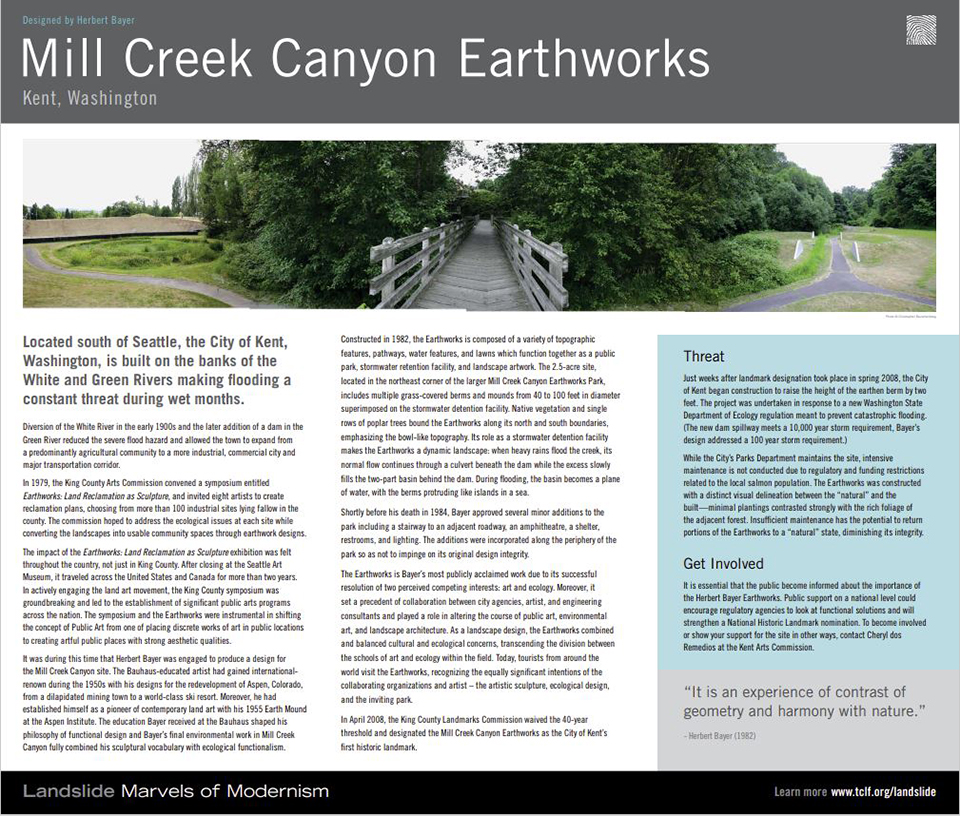
Mill Creek Canyon Earthworks Signboard, Marvels of Modernism, 2008. Image courtesy The Cultural Landscape Foundation.
Advocacy and Engagement for Mill Creek Canyon Earthworks
The Earthworks was featured in the report and traveling photographic exhibition Landslide 2008: Marvels of Modernism, which highlighted the threat to examples of Modernist landscape architecture. The photographic exhibition, done in partnership with the George Eastman House, International Museum of Photography and Film, as well as Garden Design, was the focus of media attention, including a feature in the New York Times, and was shown at venues across the country including the Centennial Center Gallery in Kent, WA, and the Andy Warhol Museum in Pittsburgh, PA. Design Within Reach showrooms and regional American Society of Landscape Architects chapters (including New York, Chicago, Northern California, Illinois, and others) co-hosted traveling signboard exhibits that were displayed in more than a dozen cities.
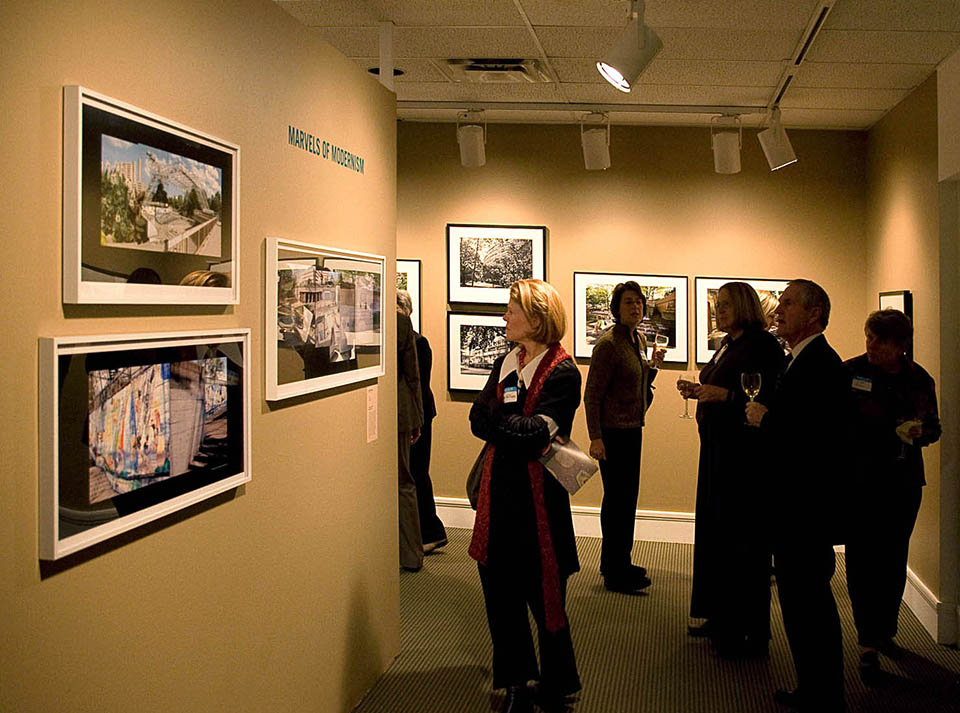 Opening of Landslide 2008: Marvels of Modernism exhibition, George Eastman House, International Museum of Photography and Film, Rochester, N.Y., 2008. Photo by Sam Sweezy, courtesy The Cultural Landscape Foundation.
Opening of Landslide 2008: Marvels of Modernism exhibition, George Eastman House, International Museum of Photography and Film, Rochester, N.Y., 2008. Photo by Sam Sweezy, courtesy The Cultural Landscape Foundation.
Though the significant character-defining elements of the Earthworks retain remarkable integrity, just weeks after its landmark designation took place in spring 2008, the City of Kent began construction to raise the height of the earthen berm by two feet. The project was undertaken in response to a new Washington State Department of Ecology regulation meant to prevent catastrophic flooding. (The new dam spillway meets a 10,000-year storm requirement, whereas Bayer’s design addressed a 100-year storm requirement.) City of Kent staff and King County Historic Preservation staff are working closely with environmental engineers to minimize the visual impact and oversee construction.
The City’s Parks Department maintains the site. Today, due to financial constraints, only limited maintenance is carried out. When the Earthworks was constructed, the visual delineation between what was “natural” and what was built was distinct, due in large part to the limited palette of lawn and poplar trees, which contrasted strongly with the richly textured contiguous forest edge.
Currently there is a master planning process underway for Mill Creek Canyon. This work, which is being spearheaded by Parks Planning and Development Division, is developing a long-term reinvestment strategy for both the Earthworks and the rest of the trails and spaces throughout Mill Creek Canyon Park. The pre-final draft plan has been generated with extensive community engagement. Officials hope to invest in Mill Creek Canyon Park in a way that brings greater local attention to Bayer’s Earthworks and ensures its integrity.
Founded in Washington, D.C., in 1888, the National Geographic Society relocated its headquarters to Hubbard Memorial Hall on the corner of M Street and Sixteenth Street in 1903. As the organization and its publication, the magazine National Geographic, grew in popularity throughout the twentieth century, the headquarters expanded along M Street to include an administrative building (1931), an editors’ wing (1948), and an eleven-story office building designed by Modernist architect Edward Durell Stone (1961). After the editors’ wing was demolished, a second multifunctional building containing a 400-seat theater, alongside a publicly accessible outdoor plaza, was completed by the firm Skidmore, Owings & Merrill (SOM), working with landscape architect James Urban, in 1981. In 1984 the sculpture MARABAR, commissioned by National Geographic with guidance from SOM’s David Childs and designed by artist Elyn Zimmerman, was installed within the plaza. Zimmerman considered MARABAR her most important work.
Background
The headquarters enclose an elongated plaza framed by buildings that reflect various twentieth-century architectural styles. Looping around a planted median, a drop-off is bordered by a low-curbed sidewalk, minimizing the separation of pedestrian and vehicular access. The median, containing a staircase to an underground garage, is planted with oaks, holly, and boxelder trees, corresponding with adjacent garden beds. Original ash and pear trees have since been replaced by oaks.
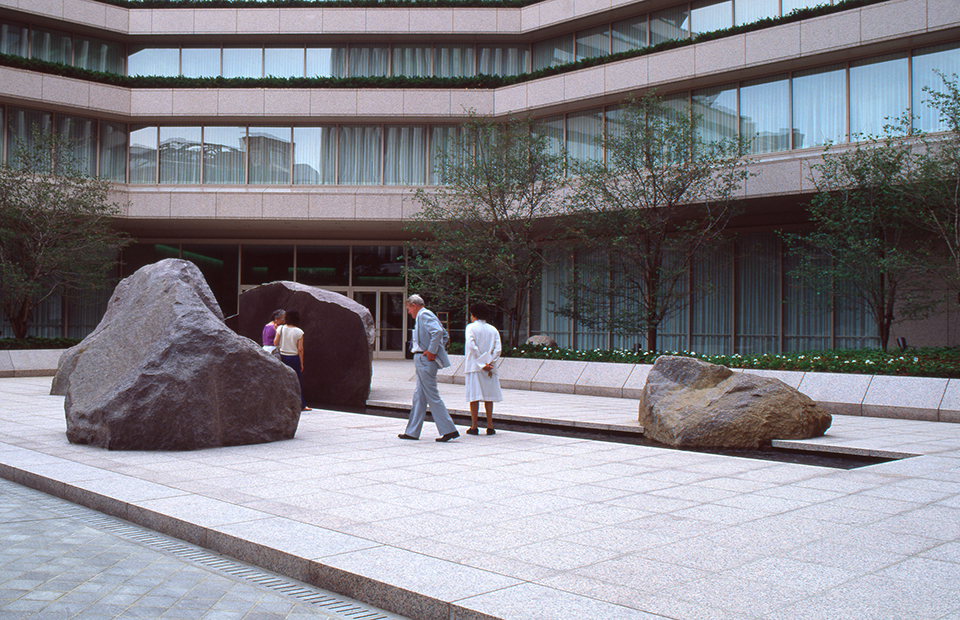 MARABAR, National Geographic, Washington, D.C., 1984. Photo courtesy Elyn Zimmerman.
MARABAR, National Geographic, Washington, D.C., 1984. Photo courtesy Elyn Zimmerman.
Several boulders strategically placed throughout the plaza’s gardens are part of the sculptural installation MARABAR, whose main element is a rectangular reflecting pool (six x 60 feet) set immediately amid five of the granite boulders, three of which have highly polished and reflective surfaces, mirroring one another across the pool (there are seven additional boulders located in the plaza). Because the boulders sink slightly below the pavement, which also hovers above the water, the plaza's natural elements appear to antedate the man-made construction. The plaza narrows into a sheltered, well-shaded garden space before transitioning to an alley exiting onto Sumner Row. The stepped terraces of SOM’s building, once containing yews, have been replaced with grass. Repeating rows of hedges edge the exhibition hall’s colonnade.
In November 2017, NGS told Zimmerman MARABAR would have to be removed to allow a plaza redesign. A proposal by Hickok Cole Architects received construction approval from the city’s Historic Preservation Review Board (HPRB) in August 2019.
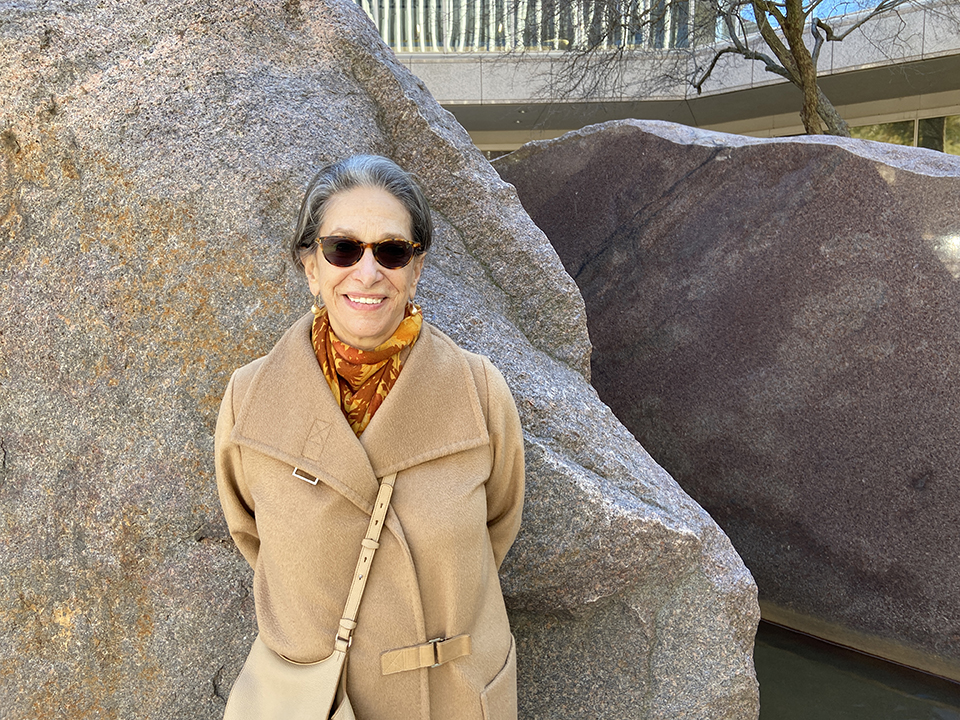
Elyn Zimmerman at MARABAR, National Geographic, Washington, D.C., 2021. Photo by Charles. A Birnbaum, courtesy The Cultural Landscape Foundation.
Advocacy and Engagement for Sudama (MARABAR)
In March 2020, TCLF first learned of the proposed removal, which the artist considered would be the work’s demolition. At the time Zimmerman noted, “I didn’t realize – but TCLF did – that the new NGS architects did not represent their intentions about removing MARABAR to the D.C. Historic Preservation Review Board”; this omission constituted a reason for the Board to initiate a new review before issuing any building permits. The HPRB reopened their August 2019 approval after TCLF demonstrated that the plans submitted for the Board’s review did not adequately illustrate MARABAR. While the HPRB concluded it did not have jurisdiction, pressure began to find an alternative to demolition.
TCLF enrolled the site in its Landslide program of at-risk landscapes on March 31, 2020, and mounted a strategic communications plan that yielded extensive media coverage, including five articles in the New York Times, Chicago Tribune, Baltimore Sun, Arch Daily, ArtNet News, Art Newspaper, Washington Business Journal, and numerous others, and more than two dozen letters from cultural and art world leaders, among them Whitney Museum of American Art director Adam Weinberg and New Yorker writer Adam Gopnik.
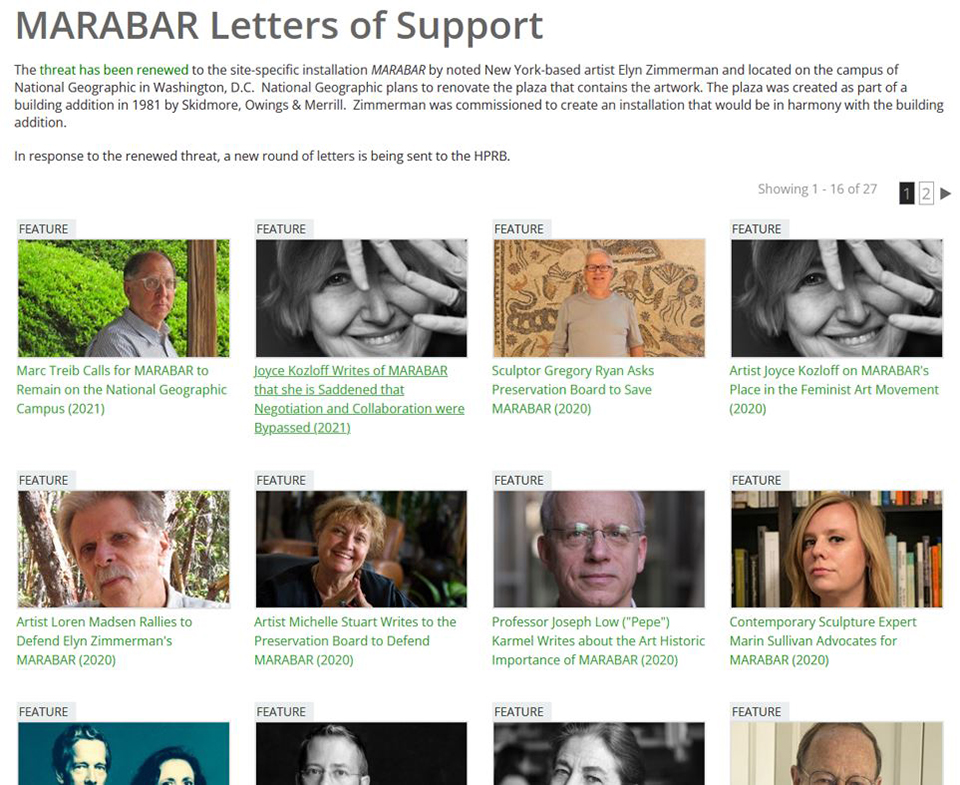 Screen capture from 27 Letters of Support for MARABAR, 2020-2021. Image courtesy The Cultural Landscape Foundation.
Screen capture from 27 Letters of Support for MARABAR, 2020-2021. Image courtesy The Cultural Landscape Foundation.
NGS ultimately agreed to relocate part of the installation at their expense and under Zimmerman’s direction. MARABAR was disassembled in 2022. After visiting various potential properties, Zimmerman chose an ellipse on the American University campus across Massachusetts Avenue from the Katzen Arts Center, where the structure would be visible from Ward Circle. The artist worked with the Washington, D.C.-based landscape architecture firm Lee and Associates, Inc. Beginning in September 2022, the 450,000-pound installation principally comprised of five mahogany-colored South Dakota granite boulders arranged on either side of a crescent-shaped pool, was installed on an elevated site behind the university’s Kay Spiritual Life Center, accessed via a staircase from Massachusetts Avenue and ramping walks. The work, renamed Sudama, was gifted by NGS and dedicated on April 4, 2023.
In her public remarks at Sudama’s unveiling, Zimmerman said three years ago she was in “despair” about the future of MARABAR. In an interview at the time with TCLF Zimmerman stated, “Once the conversation about Marabar changed, due to the efforts of TCLF and others, its destruction was avoided. The National Geographic Society and I worked together with a team of experts to enable the transition to proceed. It is something of small miracle that droit moral applied to Marabar led to its preservation and reconstruction as Sudama.”
The names MARABAR and Sudama come from E.M. Forester’s novel A Passage to India. Marabar is derived from the Barabar Caves, while Sudama is the name of a Barabar Cave.
Selected Resources
“Lower Manhattan’s 140 Broadway Under Threat, January 29, 2018
“Plans Altered for Redesign of 140 Broadway,” March 20, 2018
“Rehabilitating Postwar Plazas: A Primer,” December 5, 2019
Green Acres Saved,” Landslide Update, August 28, 2012
The Works of Athena Tacha, Art and the Landscape, Landslide 2014:
“From Marabar to Sudama – A Q&A with Artist Elyn Zimmerman”
“TCLF Talks to Elyn Zimmerman,” March 26, 2020
“A Red-Letter Year for Women, But Not for Their Art,” April 28, 2020
“Playing Hardball at Nat Geo,” Landslide Update, May 26, 2020
"Nat Geo’s Plans to Destroy MARABAR Put on Hold,” Landslide Update, June 5, 2020
“MARABAR is Saved,” Landslide Update, March 11, 2021
Selected Media Coverage
“Lower Manhattan’s celebrated 140 Broadway may get unwelcome ornament,” Amy Plitt, January 30, 2018 “Lower Manhattan’s 140 Broadway Modernist Building At Risk,” Susan Xu, Untapped New York, February 1, 2018 “Proposed 140 Broadway Plan Threatens Noguchi’s “Red Cube,” Elena Goukassian, Hyper Allergic, February 1, 2018 “Critics Lash Out at Redesign Proposal for Landmark 'Red Cube' Plaza,” Carl Glassman, Tribeca Trib, February 5, 2018 “Art vs Nature: Should NJDEP junk sculpture garden?,” Frank Brill, Enviropolitics Blog, August 9, 2012 “DEP's plan to replace Trenton sculptural plaza with 'rain garden' met with furor from arts groups,” Peggy McGlone, The Newark Star Ledger, July 27, 2012 “Editorial: Kudos for preserving 'Green Acres' sculpture outside DEP office in Trenton,” The Times of Trenton, September 9, 2012 “Plan to Demolish Public Sculpture Meets With Pushback,” Annie Knox, New Jersey Spotlight, August 7, 2012 “Public Art and Argument,” Agnes Gund, Huffington Post, August 9, 2012 “State plan to demolish Trenton sculpture draws lawsuit threat from artist,” David Loring, The Times of Trenton, July 27, 2012 “Saving That Landscape, in Pictures at Least,” Kathryn Shattuck, The New York Times, November 21, 2008 "National Geographic Headquarters plaza redesign threatens historically significant sculpture,” Shane Reiner-Roth, Architect’s Newspaper, March 31, 2020 Elyn Zimmerman’s MARABAR at National Geographic Society HQ Threatened with Demolition,” Editorial, East City Art, April 28, 2020 “A Million-Pound Artwork, Once Threatened, Finds a New Home,” Rebecca J. Ritzel, The New York Times, December 28, 2021 “In New Plan, National Geographic Will Move an Acclaimed Sculpture,” Rebecca J. Ritzel, The New York Times, March 9, 2021 “They Have Finished Moving 225 Tons of Reimagined Art,” Rebecca J. Ritzel, The New York Times, April 3, 2023 “Plan to Remove a Million-Pound Granite Sculpture Draws Fire,” Rebecca J. Ritzel, The New York Times, May 8, 2020 “National Geographic Plan to Dismantle Granite Sculpture Hits Snag,” Rebecca J. Ritzel, The New York Times, May 28, 2020 “‘Marabar’ Has a New Home—and a New Name—at American University,” Jessica Ruf, Washingtonian, April 4, 2023 “Elyn Zimmerman’s monumental MARABAR finds a new home at American University,” Matt Hickman, The Architect’s Newspaper, December 30, 2021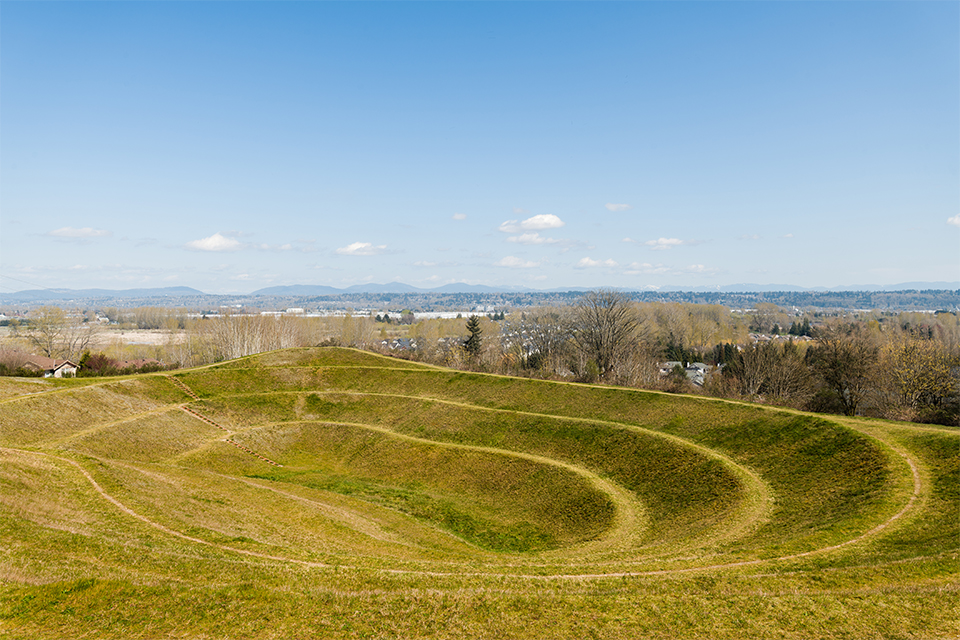
-
Robert Morris (1931-2018). Untitled Earthwork (Johnson Pit #30), 1979. Terraced earth and rye grass. SeaTac, WA. King County Public Art Collection. Photo: joefreemanjunior.com
